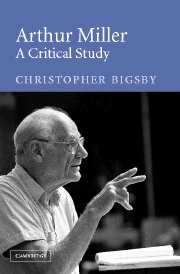Book contents
- Frontmatter
- Contents
- Acknowledgements
- Note on the text
- Introduction
- 1 The Michigan plays
- 2 The Golden Years, The Half-Bridge, Boro Hall Nocturne
- 3 The radio plays
- 4 The Man Who Had All the Luck
- 5 Focus
- 6 All My Sons
- 7 Death of a Salesman
- 8 Arthur Miller: time-traveller
- 9 An Enemy of the People
- 10 The Crucible
- 11 A Memory of Two Mondays
- 12 A View from the Bridge
- 13 Tragedy
- 14 The Misfits
- 15 After the Fall
- 16 Incident at Vichy
- 17 The Price
- 18 The Creation of the World and Other Business
- 19 The Archbishop's Ceiling
- 20 Playing for Time
- 21 The shearing point
- 22 The American Clock
- 23 The one-act plays: Two-Way Mirror, and Danger: Memory!
- 24 The Ride Down Mount Morgan
- 25 The Last Yankee
- 26 Broken Glass
- 27 Mr Peters' Connections
- 28 Resurrection Blues
- 29 Finishing the Picture
- 30 Fiction
- 31 Arthur Miller as a Jewish writer
- Notes
- Index
Introduction
Published online by Cambridge University Press: 16 November 2009
- Frontmatter
- Contents
- Acknowledgements
- Note on the text
- Introduction
- 1 The Michigan plays
- 2 The Golden Years, The Half-Bridge, Boro Hall Nocturne
- 3 The radio plays
- 4 The Man Who Had All the Luck
- 5 Focus
- 6 All My Sons
- 7 Death of a Salesman
- 8 Arthur Miller: time-traveller
- 9 An Enemy of the People
- 10 The Crucible
- 11 A Memory of Two Mondays
- 12 A View from the Bridge
- 13 Tragedy
- 14 The Misfits
- 15 After the Fall
- 16 Incident at Vichy
- 17 The Price
- 18 The Creation of the World and Other Business
- 19 The Archbishop's Ceiling
- 20 Playing for Time
- 21 The shearing point
- 22 The American Clock
- 23 The one-act plays: Two-Way Mirror, and Danger: Memory!
- 24 The Ride Down Mount Morgan
- 25 The Last Yankee
- 26 Broken Glass
- 27 Mr Peters' Connections
- 28 Resurrection Blues
- 29 Finishing the Picture
- 30 Fiction
- 31 Arthur Miller as a Jewish writer
- Notes
- Index
Summary
Henrik Ibsen's writing career stretched over forty-seven years, Strindberg's over thirty-seven. Chekhov's lasted twenty years. In 2002, sixty-six years had passed between Arthur Miller's No Villain, a university play which won two prizes, and Resurrection Blues, voted best new play first produced outside New York. Two years on, in 2004, came Finishing the Picture.
Longevity, of course, is no virtue, unless you happen to be a Galapagos turtle. In Miller's case, however, nearly seventy years as a writer had seen a succession of plays that served to define the moral, social and political realities of twentieth- and then twenty-first-century life. At the turn of the millennium, British playwrights, actors, directors, reviewers and critics voted him the most significant playwright of the twentieth century with two of his plays (Death of a Salesman and The Crucible) in their top ten.
Curiously, he had fallen out of favour in his native America for the previous thirty years. His new plays were not well received, even as his classic plays of the 1940s and 50s were taught in schools and universities and regularly revived. Elsewhere in the world, however, his plays of the 1970s, 80s and 90s found a ready audience. In 1994, Broken Glass, his play set at the time of Kristallnacht, was poorly received in New York while winning the Olivier Award, in Britain, as best play of the year.
- Type
- Chapter
- Information
- Arthur MillerA Critical Study, pp. 1 - 7Publisher: Cambridge University PressPrint publication year: 2004



